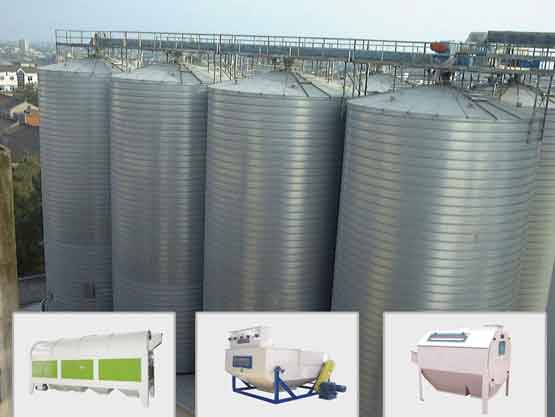How to Clean Grain Steel Silo Before Usage
Initial Cleaning Definition
Initial cleaning is an important process of grain steel silo before inputting storage materials, which achieves the aim by use of related initial facilities. With being widely used in grain processing industry, storage safety of grain steel silo has attracted more and more attention.
Storage Affecting Factors of Grain Steel Silo
Grain that is stored in steel silo is mainly affected by the following factors: Grain moisture; Grain temperature; Impurities; Other factors (such as: pests, etc).
Controlling the above factors is the key to safe storage. But the above factors are actually related.
Generally, when grain moisture is higher, grain temperature is easier to rise up, and the higher grain temperature intensifies respiration of grain, therefore further increase grain moisture. So that would cause a vicious circle, resulting in a serious damage for grain quality. In addition, if grain contains more impurities, grain moisture rate in some parts of silo would probably exceed the required standard of impurity rate, resulting in increasing temperature of grain. If that happens at the bottom of the silo, , it would make the temperature of all of grain rapidly rise up because hot and humid air flows to the upstream, resulting in grain quality reduction.

According to real practice, the problems of grain moisture in the processes of grain production and transportation have been paid more and more attention and basically solved now. But the negative effect of impurities in grain has not been given the much attention and better solution for a long time due to the characteristics of steel silo itself.
The grain steel silo is generally higher than the others (for large steel silo, its height is 26m, overall height can reach ≥34m), which adopts center inputting way generally. This makes the inputting grain stream be affected by airflow obviously. The result is serious grading of grain: to form several cylindrical regions of impurities aggregation from the center to the edge of silo. The impurities can easily absorb moisture and mildew, thereby affecting grain quality of entire silo.
Different Kinds of Impurities Have Different Effects for Grain
- Light impurities (such as corn skin), which have higher water absorption rate, are easy to cause some parts of grain to contain too much water, resulting in grain storage heating.
- Small impurities (such as dust, broken grain) can probably block in the space and affect air circulation in interior grain, causing further heating because of their small size.
- Big impurities (such as stones, pods, corn stick) can often have adverse effect on the normal operation of inputting equipment instead of grain itself.
Seen from the above results, cleaning the impurities in the grain is one of key factors for safe storage of grain. Especially people should clean up the light impurity and small impurities. Therefore, relatively complete inputting process of the steel silo is generally equipped with initial cleaning at least.
Initial Cleaning Facilities
The typical inputting process of silo is as follows: Through initial cleaning sieve and de-ironing separator, grain is put into silo. The initial cleaning sieve is with a set of dust screen. Here the sieve is responsible for removing big impurities, and dust screen can remove most of light impurities. De-ironing separator can remove magnetic metal (such as iron, nails) from grain to protect the inputting facilities. Therefore, de-ironing separator can’t be seen as initial cleaning facilities.
Initial Cleaning Jobs
The common initial cleaning sieve includes: grille board, mesh-belt initial cleaning sieve, cylindrical initial cleaning sieve, double cylindrical initial cleaning sieve, etc. Of them, grille board is generally placed in the inputting hole, which not only can play a supporting role, but also remove some larger impurities, such as stones, linen sheet pieces. Mesh-belt initial cleaning sieve is just equivalent to a layer of improved grille board, which just can clean out the impurities such as stones, linen sheet pieces, corn cob. For light and small impurities, its effect is relatively bad. So it has gradually been eliminated and rare in use now. Cylindrical initial cleaning sieve is compact in structure, so it can clean up most of big impurities and some small and light impurities. But due to its low work efficiency, it is generally suitable for <80t/h work state. The double cylindrical initial cleaning sieve is with inside and outside sieves, which can effectively clean up big and small impurities. Being equipped with a dust screen, it can more effectively remove most of light impurities, and its work efficiency can reach 100-300t/h. So it is the better initial cleaning facilities.
In practical use of initial cleaning sieve, forgetting its matched dust screen is the common mistake by worker. Indeed, in the initial cleaning process dust screen is the key facility. Here, its functions mainly include:
- Cleaning sieve surface;
- Preventing sieve holes from being blocked for normal operation of the facilities;
- Removing part of small impurities and most of light impurities;
- Assisting cleaning effect with suitable dust collector;
- Keeping a certain negative pressure inside the sieve to avoid spillover.
Because of a large amount and high concentration of dust in the air, the dust collector facilities are often working in heavy load. Thus only one set of facilities is difficult to meet the requirements. Two sets of facilities will fit for it. First set, cyclone separator; second set, bag-type dust collector. This can achieve a good dust removing effect, and reduce the load of bag-type dust collector to protect it.
Initial Cleaning Services
The initial cleaning purpose is not to completely clear up all the impurities in raw materials to meet production requirements. The sole purpose is to protect the facilities and ensure the safety of grain storage. If you want to completely remove the impurities in the raw material, you require multiple cleaning facilities.
Flyer can provide you with best initial cleaning services at lowest and most reasonable initial cleaning cost.
 Español
Español
